#sant climent de taüll
Text
Mirant a Sant Climent de Taüll
Aquella mañana nos levantamos tarde. Él tenía migraña. Yo aún el miedo en el cuerpo. La proximidad física con mi exmarido del día anterior me había dejado noqueado. Mi organismo estaba en colapso.

Quizás por ese motivo y no por otro no me acerqué a la iglesia de Sant Climent de Taüll. Esbelta y majestuosa pero también tradicional y atávica. Igual que él. Me refiero aquí al él de antes, que no al de ahora.

El él de ahora rehúye las tradiciones sin hacer ruido. El él de antes persigue las tradiciones con bombo y platillo. Yo persigo y rehuyo a todos ellos a un mismo tiempo. Esa parece ser mi esencia...

Durante los cuatro días que permanecimos bajo el techo de un apartamento frente a la famosa y románica iglesia no sentí el impulso de penetrar en sus muros. Aún hoy me pregunto por qué...









#inventario ulterior#inventari ulterior#sant climent de taüll#taüll#vall de boí#lleida#alta ribagorça#pirineos#pirineus#visita#herba#floretes#primavera#botes
0 notes
Text


king arthur in llandaf cathedral (cardiff) and statue of saint gildas near the village of saint-gildas-de-rhuys (france), galahad by joseph noel paton and hand of god in a fresque in sant climent of taüll (catalonia)
[ID 1: a stained glass window focused on a man wearing gold scale armour with a blue sash. Next to it is the statue of a bearded bald man wearing robes. /end ID 1
ID 2: an oil painting of a young blond man on a horse. And angel is flying beside him giving off light. Next to it is a picture of a single hand emerging from a pale space surrounded by coloured rings. /end ID 2]
#king arthur#st gildas#galahad#arthur x gildas#galahad x god#arthuriana ship bracket#arthuriana#arthurian literature#arthurian legend
19 notes
·
View notes
Video
youtube
Románico: tiempo - espacio en Sant Climent de Taüll
El Cristo en Majestad de la iglesia de Sant Climent de Taüll es uno de los símbolos del arte Románico. Estas imágenes no alcanzan a analizarse adecuadamente si solo pensamos en ciertos aspectos formales. Vamos a necesitar comprender la integración de las artes del Románico, qué pensaba el espectador medieval ante estas imágenes y cómo el uso de la ventana nos aporta otra ecuación por sobre la típica idea de la representación albertiana. El mundo Románico es metonímico antes que metafórico y eso nos obliga a replantearnos las herramientas para abordar este momento de la Historia del Arte.
0 notes
Text
Iconography: JC Part 1

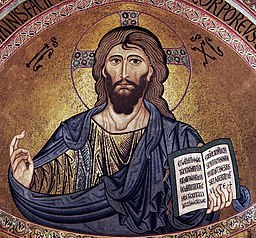


Christ in Majesty, fresco. Circa 1123. Master of Taüll. Apse of Sant Climent de Taüll Museu Nacional d'Art de Catalunya, Barcelona
Christ Pantocrator, mosaic. 1130. Cefalù Cathedral. Cefalù, Italy. 📷 Wikimedia Commons, Andreas Wahra, CC BY-SA 3.0
Christ in Judgment, tympanum, 1150. Abbey Ste Foy📷 Daniel Villafruela, CC BY-SA 3.0 via Wikimedia Commons
The Deesis mosaic, 1280. Hagia Sophia, IstanbuI, Turkey. Wikimedia Commons © JoJan, CC BY-SA 3.0
You've seen Him in frescos, mosaics, tympanum, paintings, illuminated manuscripts and more but do you know your Christ in Majesty from your Christ Pantocrator? The difference between Christ in Majesty and Christ in Judgment? What about the Christ Pantocrator and the Deesis?
Although sharing some similarities, the iconography of Christ differs between the Western Church and Eastern Orthodox Church.
The distinction comes from how both Churches interpreted the Heavenly throne described in The Book of Revelation and how those interpretations were then depicted in church architecture that developed in the East and West.
Early Christian art
Generally divided into two periods by scholars, early Christian art is bucketed into one of two camps: before and after either the Edict of Milan of 313 (whereby Christians were legally protected from persecution) or the First Council of Nicea in 325 (where Constantine I called for a meeting of all the Christian bishops to try to define Christian doctrine for all their followers around the Empire).
One of the major reasons for convening the council was major questions was around Christology. Specifically, what was the relationship between God the Son and God the Father. This concept is confusing and needed some consensus for sure (spoiler- was not figured in 325).

Regardless of the marker, once Christians were able to freely express themselves and their ideas about God in overt ways, a process began where the underground (literally in the catacombs), indirect symbols and ambiguous iconography of a persecuted people would evolve into mainstream icons for the all the world to see.
How would older symbols continue to be used? What new ones would develop? And, of course, where would Christians put them all?
Brief Christian History timeline
313 - Edict of Milan
325 - First Council of Nicea
324 - Constantine makes Byzantium the new capital of Roman Empire
330 - Byzantium becomes Constantinople
380 - Christianity becomes the state church of the Roman Empire
Late 5th century - collapse of the Western Roman Empire
Roman Empire 379-1453

Christian architecture
Christians would model their places of worship on the basilica, originally a large multi-functional public building in ancient Rome. The design of the original basilica was a rectangle shape with a longitudinal nave with an apse on one end (there could be more) and a roof with two levels, the higher roof in the middle to allow for a clerestory above.
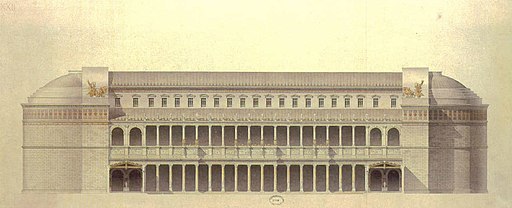
19th century reconstruction of the 2nd century AD Basilica Ulpia, part of the Trajan's Forum, Rome. Julien Guadet, prix de Rome, Public domain, via Wikimedia Commons
The basilica quickly became the template for a standardized architecture of Christian worship, the church. Specific features would Christianize for the church's needs, like the apse. In a civil basilica for example, the apse was the place where officials would congregate and where the Emperor would sit, in the Christian basilica it would become the place above the altar, where Jesus would be depicted. As time went on, the two Churches would use the space in ways that would effect the Christian art made inside.

Basilica of Sant'Apollinare in Classe near Ravenna, Italy, 6th century. Angela Rosaria, CC BY-SA 3.0, via Wikimedia Commons
Christian art
The various versions of Christ would gradually take form inside these churches, birthing the predecessors of the standardized iconography that would become the Christ in Majesty and the later Christ in Judgement and the Deesis and Christ the Pantocrator.
By the 4th, 5th and 6th centuries, the change was underway. It is as if artisans were thinking out loud on how to interpret the Old and New testaments, their images of a personified Jesus could be depicted in various ways - as a young, short haired, beardless, law giver, shepherd or even a warrior as well as bearded, long-haired and older, like the version standardized today.
Young, beardless Christ

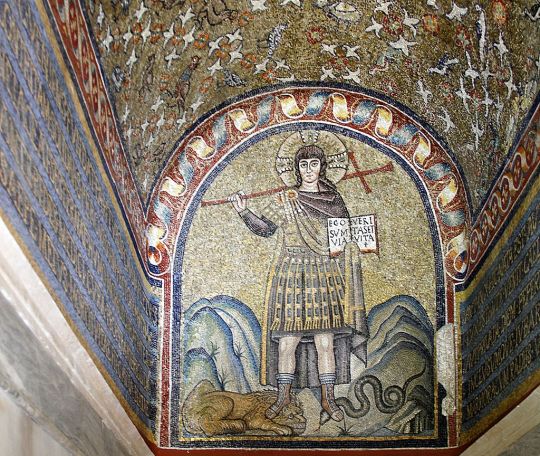
[Left] Christ the Lawgiver. Basilica of San Lorenzo, Milan, Italy. 4th century. Wikimedia Commons © Giovanni Dall'Orto
[Right] Christ treading the beasts. Chapel of Saint Andrew, Ravenna, Italy. 6th century. Wikicommons © José Luiz Bernardes Ribeiro
The mosaics above reflect important symbols and ideas of the time. In Christ the Lawgiver, Jesus is surrounded by his disciples. He is beardless, donning a golden halo. He is dressed in a white and gold toga and seated on a throne dais with his feet on a stool. His left hand holds the New Testament and raising his right hand (this right hand would have a number of meanings- from a gesture made to signal the right to speak, a gesture made by Emperors handing over a decree, to teaching gesture and finally becoming a gesture of blessing).
In Christ treading the beasts, Christ is alone, beardless, his head is surrounded by a golden four-armed cross halo. He is dressed in royal purple for battle, standing and stepping on the heads of the lion and the serpent. He is holding the Gospel with his left hand and grasping a large cross that rests on the shoulder, ready to take on any evil that may come his way.
In both cases, a young, beardless and haloed JC is taking on the appearance of a particular message the patron wants the artist to deliver to its audience.
Early Christian art was heavily influenced by Roman art and therefore the art that had influenced Rome, the art of Ancient Greece and thereby Greece's own influences - Egyptian, Mesopotamian and Persia art.
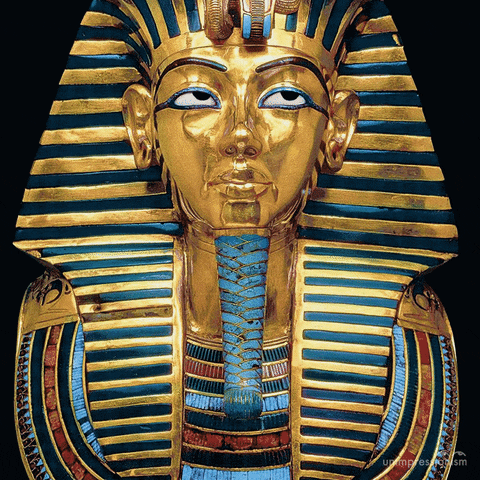
All cultures and religions take from and build upon the cultures and religions that came before them, adapting stories and visual language to suit their needs and the stories they want to tell.
If young strong Greco-Roman gods were portrayed as young and beardless, it would make sense for artists to show Christ in this way too. If deities in Ancient Egypt and Greco-Roman gods were depicted with halos/auras, Christ most certainty should too.
In the Lawgiver Christ, we see an emperor at the Forum with all other senators surrounding him. In Christ treading on beasts in Ravenna, we see a Christ in battle, triumphant against the hoards of pagan Germanic tribes to Ravenna's North or the defeat of Arianism within the Church itself.
Older, bearded Christ
The following image is said to be one of the earliest bearded Christ depictions which is now the prevailing, mainstream image we have come to know. Here Christ is fully bearded Jesus with long hair and a halo. This image emerged around 300, but it did not become established until the 6th century in the East and much later in the West.

Bust of a Bearded Christ, Catacombs of Commodilla, Rome, Italy. Late 4th Century. Wikimedia Commons, © Public Domain
Art historians point out several possible reasons why the now conventional images of Christ are bearded. Some like Paul Zanker surmise that this version is a reflection of Zeus, the King of Roman Gods and the look of the classical Roman philosophers. It would seem to me that most adult men had beards at the time. Certainly maybe, a 33 year old, Jesus probably would not have been clean shaven.
But how do we go from the above Jesus to Christ in Majesty, Christ in Judgment, Christ Pantocrator and the Deesis?
To be continued in a future post...

Sources
Depiction of Jesus
Early Christian art and architecture
Christ in Majesty
#christ in majesty#christian art#romanesque#christian iconography#art history#iconography#mosaic#architecture
0 notes
Text
Welterbe (auf)gespürt und (er)fahren - E - Katalanische romanische Kirchen des Vall de Boí
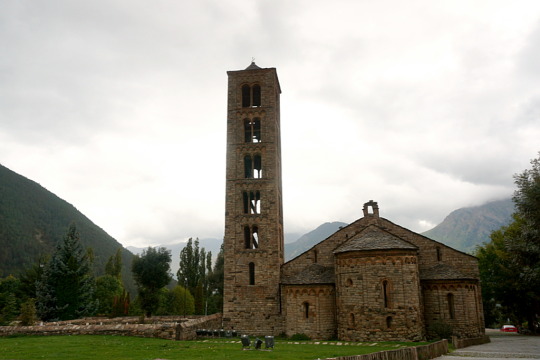
Die acht Dorfkirchen Sant Feliu de Barruera, Sant Joan de Boí, Santa Maria de Taüll, Sant Climent de Taüll, Nativitat de Durro, Santa Eulàlia d'Erill-la-Vall, l'Assumpció de Santa Maria de Coll, Santa Maria de Cardet und die Einsiedelei von Sant Quirc de Durro Vall de Boí in den hohen Pyrenäen stehen seit 2000 auf der UNESCO-Welterbeliste. Jedes der Dörfer in dem engen Tal besitzt eine romanische Kirche. Diese wurden alle in einem relativ kurzen Zeitabschnitt zwischen dem 11. und 12. Jahrhundert unter der Schirmherrschaft der Herren von Erill erbaut und sind wegen ihres Reichtums der inneren Bilddekoration sowie aufgrund ihrer Lage am Rande der jeweiligen alten Dörfer ungewöhnlich. Dieses Ensemble der bemerkenswerten Landkirchen stellt die größte Konzentration romanischer Kunst in Europa dar. Gemeinsam mit ihren Dörfern verkörpern sie eine Kulturlandschaft, die im Einklang mit einer bis heute intakten Natur gewachsen ist. Der lombardische romanische Stil der Pyrenäenkirchen drückt den einheimischen ländlichen Geist auf bemerkenswerte Weise aus. Hier geht es zum Einführungsvideo.

Meine Fahrt von Lourdes durch die Pyrenäen führt mich durch einen Zauberwald.
Im Tal scheint die Sonne, die Bergspitzen sind in den Wolken. Ich biege ins Vall de Boí ein und fahre fast ans Ende des Tals zur Kirche Sant Climent de Taüll.

Da die Kirche erst später öffnet, besuche ich oben im Ort die Kirche Santa Maria. Dabei muss ich wohl die tief hängenden Wolken berührt haben, denn sie entladen sich über mich und die Wassermassen schießen durch die schmalen steilen Gassen ins Tal.
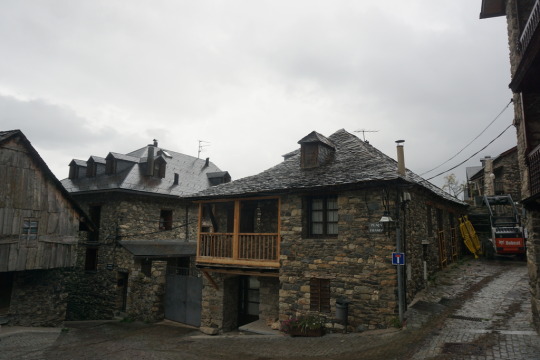

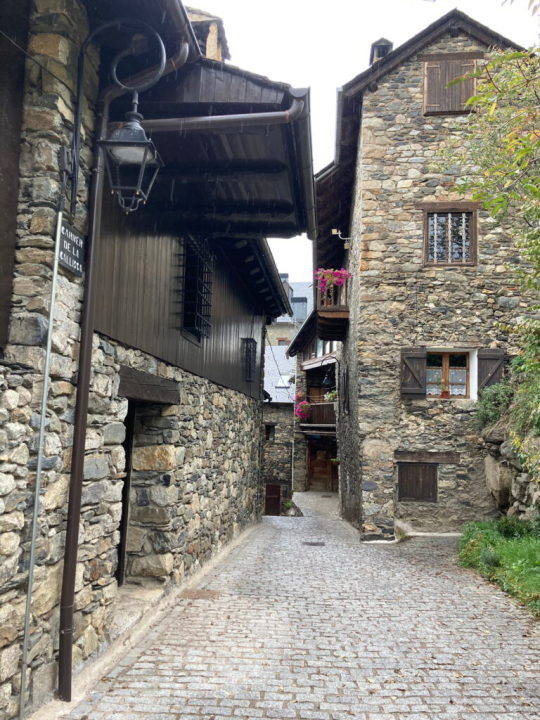
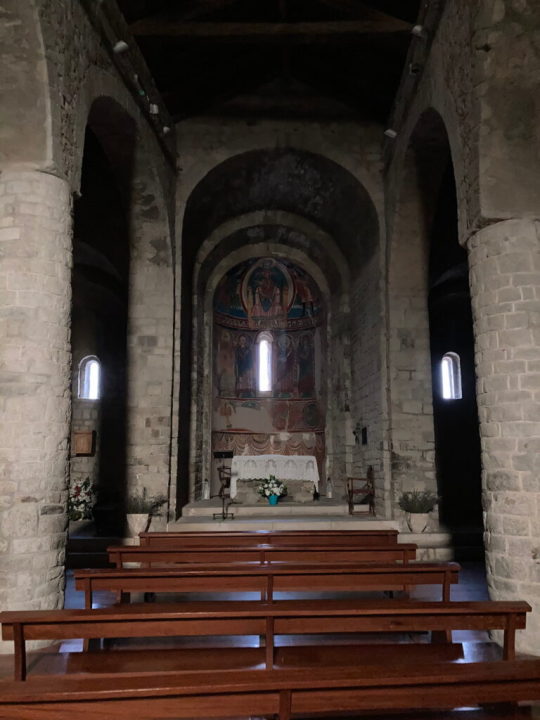
Die Kirche ist frei geöffnet und ich stehe im schummerigen Licht, das durch die schmalen Fenster fällt. Als ich den Lichtschalter gefunden habe, erstrahlen die Wandbilder in voller Schönheit. Sie stammen aus dem Jahr 1170. Beeindruckend ist der kräftig bunte geschnitzte Altar.
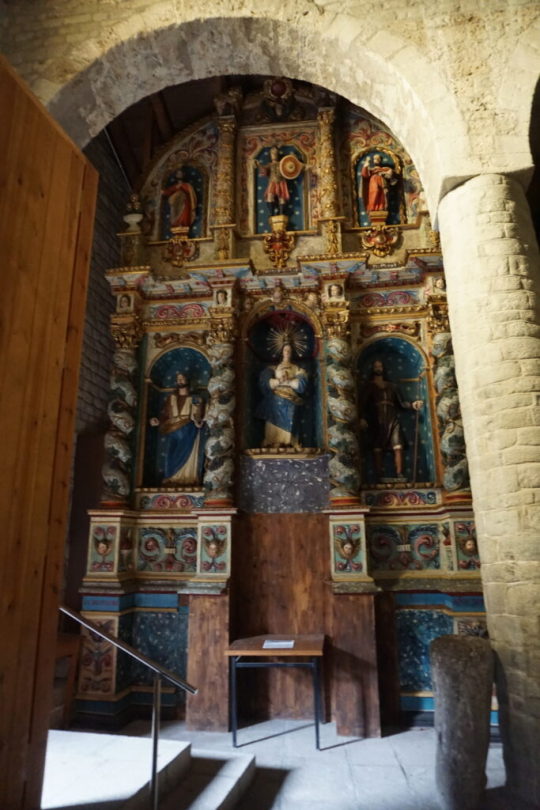
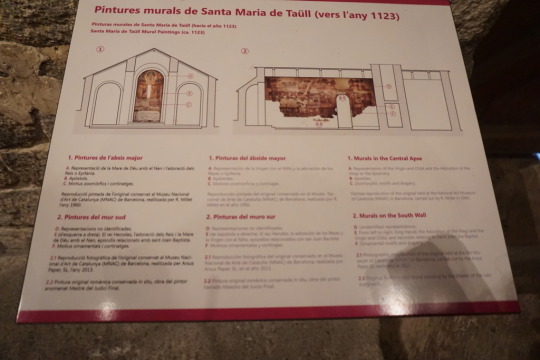

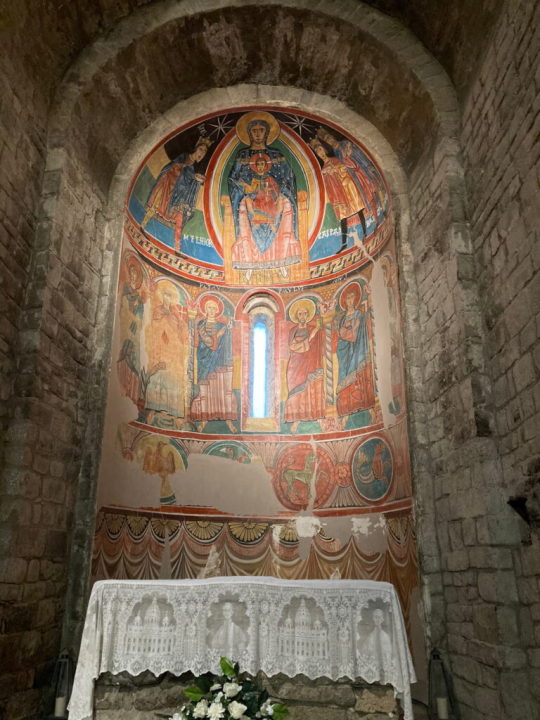
Das Highlight in der Gruppe der Kirchen ist die Sant Climent. Ähnlich herrlich bemalt und geschmückt gibt es hier viele Informationen über ihre Ausstattung und die aufwändige Rekonstruktion.
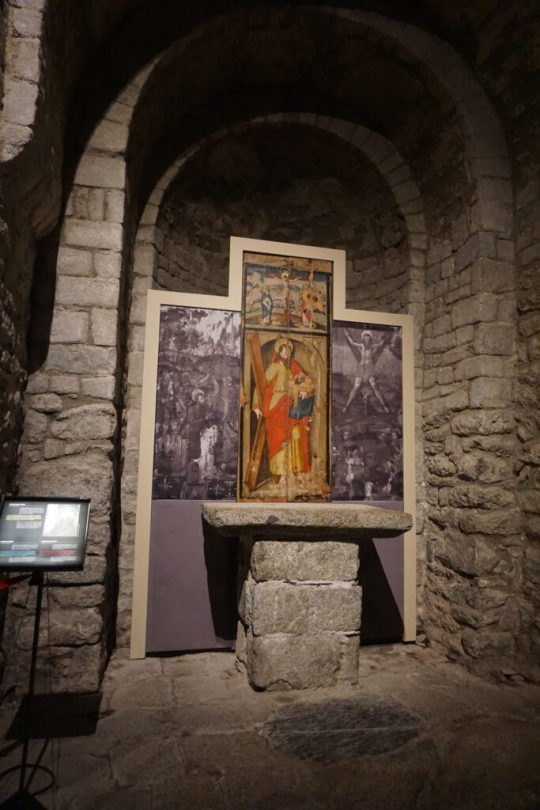


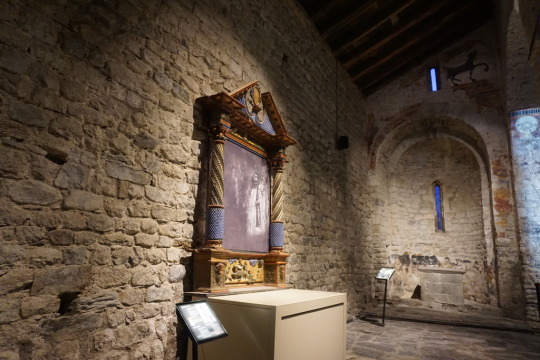
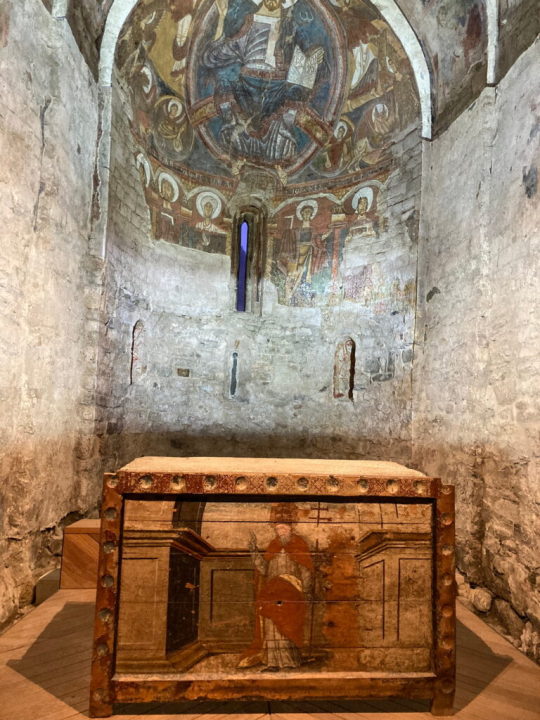
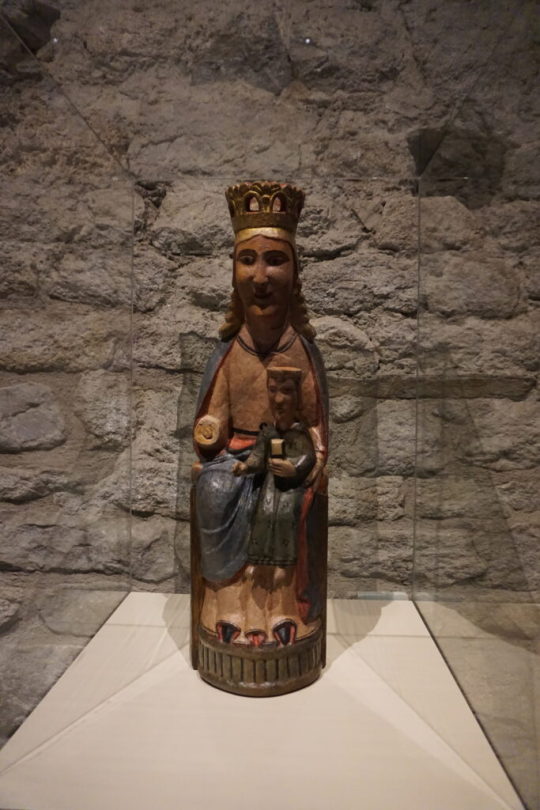
Die Besucher werden gebeten, Platz zu nehmen, das Licht erlischt, Musik und Pferdegetrappel führen uns ins Mittelalter. Und dann lassen die Projektionen die alten Bilder von 1121 vor unseren Augen im ursprünglichen Glanz auferstehen.

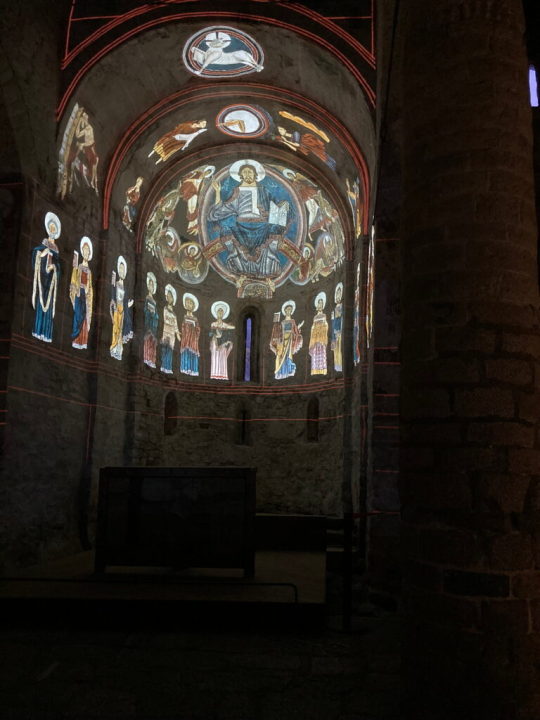
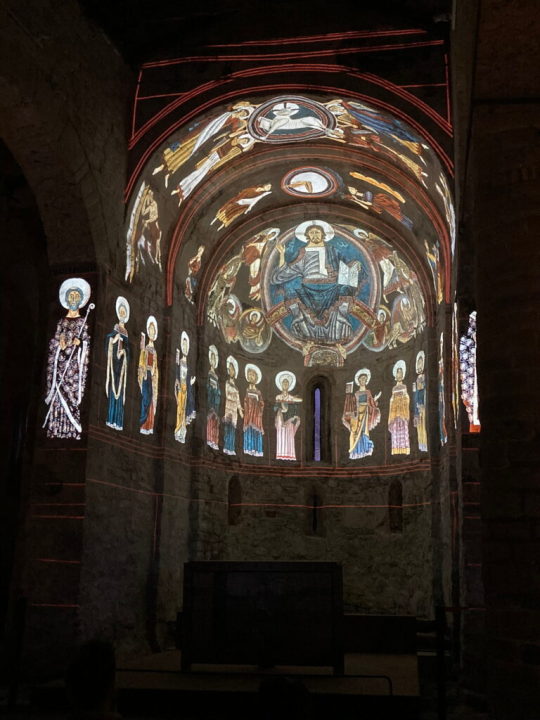
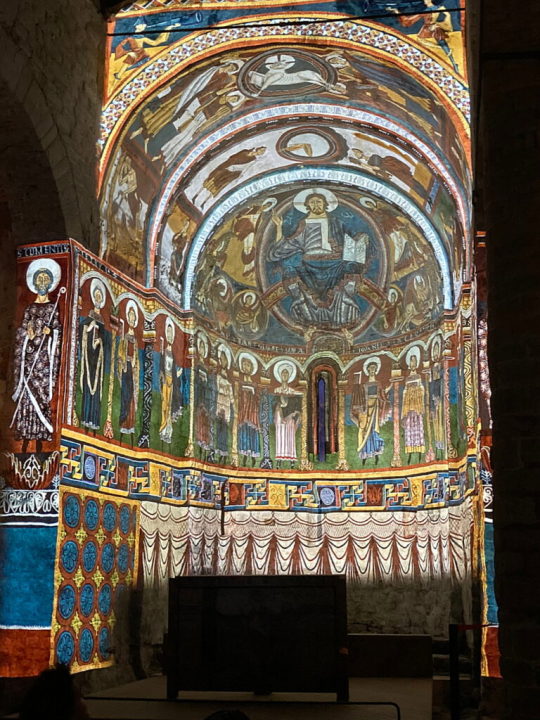
Unheimlich beeindruckt beschließe ich, dass dem nicht mehr viel hinzuzufügen sei und fahre nur noch, weiter im Regen, die Kirche Santa Eulàlia d'Erill-la-Vall an, die auf meinem Weg aus dem Tal liegt. Hier sind Schnitzereien aus dem 12. und 13. Jahrhundert zu sehen und als ich schon ein bisschen enttäuscht bin, keine bunten Wandbilder zu finden, entdecke ich, dass 75 steile Stufen bis zu den Glocken auf dem Turm führen.
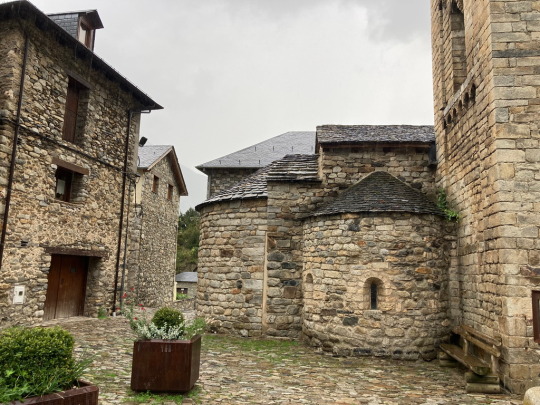
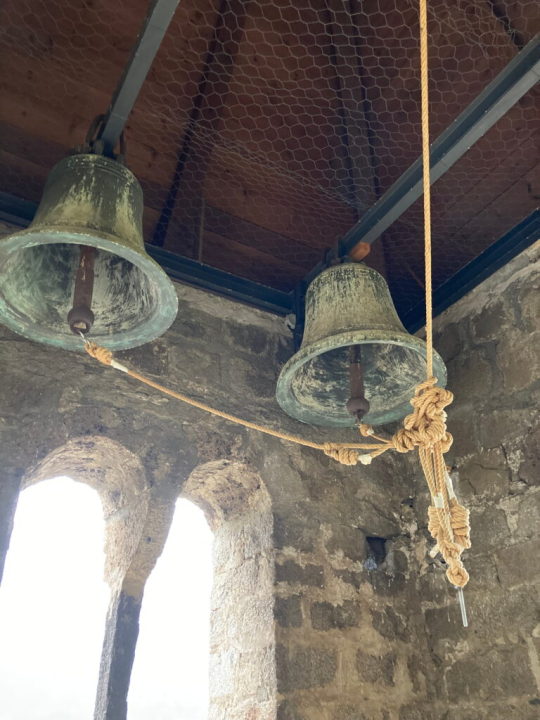

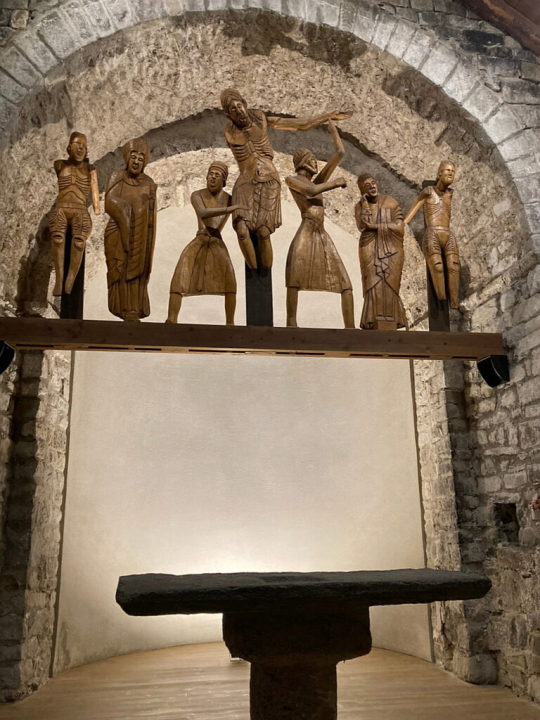
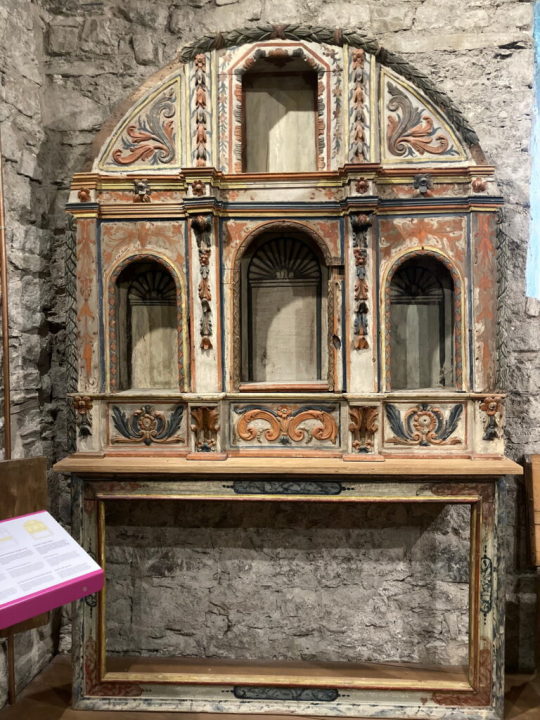


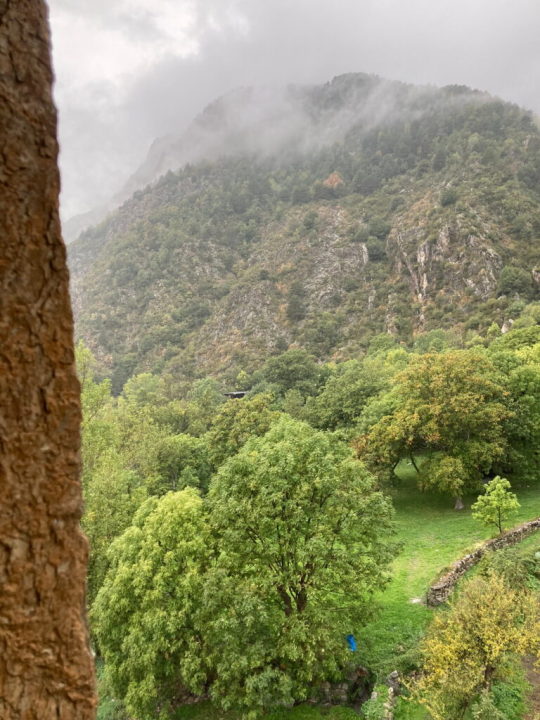
Resümee
Das Vall de Boí mit seiner wunderbaren Natur, seinen historischen Dörfern und deren beeindruckenden Kirchen ist eines der Must See in den Pyrenäen. Besonders die Sant Climent in Taüll liefert ein anschauliches Bild von der Entstehung und Bedeutung der Malerei und die Projektionsshow ist wirklich spektakulär. Bei angenehmeren Wetterbedingungen bietet es sich an, zwischen den Dörfern zu wandern und mehr Kirchen als ich zu besichtigen - dafür gibt es ein Sammelticket.
Es gelingt mir zunächst, dem Regen zu entfliehen und ich fahre Richtung Norden durch die Berge ins Gebiet des Mont Perdu. Ich komme zunächst über eine fantastische Bergstraße, die tief ein geschnitten in die Felsen ist mit Ausblicken auf die bunten Hänge und halte immer wieder an, weil ich mich an diesen Farben nicht satt sehen kann.
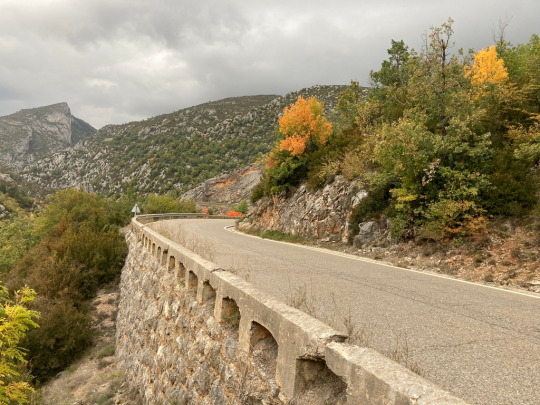

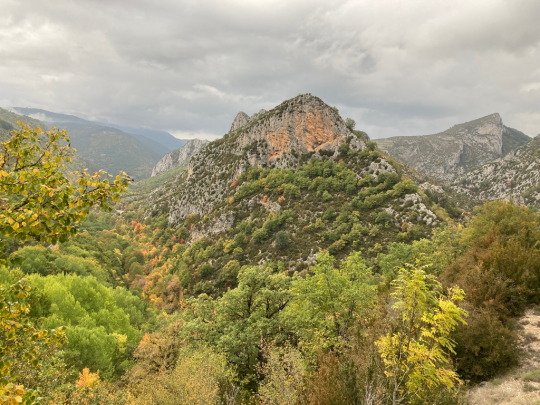
Das rächt sich dann im Nachgang, der Regen holt mich ein und nachdem ich über eine Mondlandschafts- Hochebene gekommen bin , geht es 10% über Serpentinen bergauf und -ab. Es ist schon lange dunkel, als ich endlich in einem Dorf einen Platz finde, um das Auto zu parken.
Dobbys Einrichtung und Ausstattung hat sich auch im Novemberwetter bewährt. Alle Details zum Ausbau meines Minicampers findet ihr hier: https://5-reisende.de/2022/07/29/55-000-km-on-the-road-vom-nordkapp-bis-sizilien-dobby-insights/. Meine Übernachtungsplätze habe ich wieder auf park4night gesucht und unter 5Reisende bewertet. Die App Toiletten Scout hat sich größtenteils nicht als hilfreich erwiesen.
Read the full article
#Abenteuermobil#Abenteuerreise#alleinunterwegs#Alleinreisen#Ausbau#Ausrüstung#Autoreise#Besichtigung#Camping#Camping-Mobil#Cordouan#Dacia-Dokker#DIY#Dobby#Erfahrungsbericht#Erkundung#Europa#Frankreich#Hochdach-Kombi#Inspiration#Leichtbau#Leuchtturm#Minicamper#Parkplatz#Reisebericht#Reisefotografie#Reisetagebuch#Reiseziele#Roadtrip#Rundfahrt
0 notes
Photo


Detall de l’absis de Sant Climent de Taüll, Principat de Catalunya, amb la Mare de Déu sostenint el Greal a la mà esquerra. Com que el Greal és sagrat i poderós (al cap i a la fi, és l’encarnació de Déu a la terra) aquest és agafat amb un drap.
L’església fou consagrada el 1123, i les pintures de l’absis, que devien esser pintades poc després, són atribuïdes al Mestre de Taüll. Per tant, foren pintades el segle XII.
#art#pintura#pintura romànica#fresc#romànic#Taüll#Sant Climent de Taüll#Catalunya#Pirineu#Principat de Catalunya#Greal#Déu#Divinitat#sagrat#art català#art romànic#pirinenc#pirenenc#Mare de Déu#grealenc#grial#griàlic#religió#esotèric#esoterisme#Mestre de Taüll#segle XII#1123
1 note
·
View note
Text

~ Arch of the Apocalyptic Lamb from Sant Climent de Taüll.
Date: ca. 1123
Place of origin: Church of Sant Climent de Taüll (Vall de Boí, Alta Ribagorça).
Medium: Fresco transferred to canvas
#12th century#12th century art#12th century fresco#art#fresco#arch of the apocalyptic lamb#sant climent de taüll#vall de boi#alta rigaborça#ca. 1123#history#archeology#museum#middle ages
297 notes
·
View notes
Photo

Master of Tahull
Mary, Mother of God
from the Apse of Sant Climent de Tahull
fresco
c. 1123
#master of tahull#virgin mary#saint#christianity#mural#master of taüll#sant climent de tahull#sant climent de taüll#apse of sant climent de tahull#apse of sant climent de taüll#latin#painting
2 notes
·
View notes
Photo

Knight of Swords. Art by Carmen Walker-Vazquez, from The Leeds Tarot Card Project.
“In terms of context for the design, I was heavily inspired by the 12th century frescoes in the church of Sant Climent de Taüll in Catalunya, Spain, particularly the fresco of the Lamb of God taken from the Book of Revelation, with seven eyes! The meaning of the Knight of Swords is quite ambiguous, suggesting bravery, aggression, passion and courage; yet reversed it could also imply violence, vulnerability and a stubborn or short-sighted individual. As a conflictive card, I found working on the design quite a challenge, and have made a number of different copies. I decided that the suffused and disorientating watercolour background set in contrast to the sharp black and white ink lines echoed this feeling of conflict and confusion, particularly in relation to the hot-headed figure of the Knight.”
#Carmen Walker-Vazquez#The Leeds Tarot Card Project#Knight of Swords#Knight#Swords#Minor Arcana#Tarot
4 notes
·
View notes
Text
Castarné - Taüll
Zondag 6 februari
Het is zooo een enorm koude nacht geweest 🥶, ik blaas voor het eerst wolkjes wanneer ik wakker wordt. Ik ben zo blij met mijn slaapzak, want gedurende de nacht heb ik van de kou gelukkig geen last gehad.
Na een warme kop thee en uiteraard een latte maak ik mij klaar voor een mooie wandeling hier in de buurt. Ik kan starten vanaf deze camping en dat is relaxed, geen gedoe even met inpakken en dergelijke.
Het is een rondje die mij brengt bij een oud kasteel boven op de bergtop. Vanaf daar en onderweg heb ik continu mooie panorama uitzichten over de vallei.




Ook deze route duurt ongeveer drie uur en is bijna 12 kilometer lang. Onderweg lunch ik in de zon op de mooiste plek en op het hoogste punt van deze route.




Eenmaal terug op de camping drink ik een latte en rommel ik nog wat aan. Na een uurtje pak ik de auto en rijd ik naar Taüll. Hier bezoek ik de romaanse kerk Sant Climent en Santa Maria die bekend staan om hun fresco's. Een video projectie laat een mooi beeld zien van hoe de fresco's eruit gezien hebben. Inmiddels zijn de kleuren wat vervaagd, maar zo krijg je een reëel beeld.


Eind van de middag wanneer ik terug ben op de camping zijn de meesten Spanjaarden, die hier het weekend verbleven, vertrokken. Morgen vertrek ik ook. Ik blijf wel enigzins in de buurt, want ik ga wandelen in Nacional Parque Aigües Tortes.
5 notes
·
View notes
Photo

Arch of the Apocalyptic Lamb from Sant Climent de Taüll ~ ca.1123 MNAC • via Bibliothèque Infernale on FB
294 notes
·
View notes
Video
2018 - Taüll (Catalunya) //// by Joanot Bellver
Via Flickr:
Església Romànica de Sant Climent de Taüll (Alta Ribagorça) La Vall de Boí, Catalunya ////
#Sant Climent#nic#Catalunya#Joanot#Joanot Bellver#Sony#Fullframe#A7R2#2019#Església#Romànic#Alta Ribagorça#La Vall de Boí
1 note
·
View note
Photo






I took a tiny break from Uranesia and I came up with this little church, inspired by the romanesque architecture of the Pyrenees. My main inspiration was Sant Climent de Taüll, in Vall de Boí, and its famous frescoes.
I think I will upload it :)
312 notes
·
View notes
Text
11-XI-2020: Atlas
Fig. 1. Épocas Precristianas:
Autor: Desconocido
Título: Puntas de Flecha Obsidias
Fecha: Prehistoria
Lugar: México
Fig. 2. Medievo:
Autor: Desconocido
Título: Arco del Cordero Apocalíptico de Sant Climent de Taüll
Fecha: 1123?
Siglo: XII
Técnica: Fresco pasado a tela
Medidas: Arco: 710 x 420 x 146 cm; Cordero: 113 x 146cm
Colección: Museo Nacional de Arte de Catalunya
Ubicación: Museo Nacional de Arte de Catalunya
Ciudad: Barcelona
Fig. 3. Renacimiento:
Autor: Albrecht Dürer
Título: Muerte de Orfeo
Fecha: 1494
Siglo: XV
Técnica: Tinta marrón
Medidas: 289 x 225 mm
Colección: Kunsthalle de Hamburgo
Ubicación: Kunsthalle de Hamburgo
Ciudad: Hamburgo
Fig. 4. Barroco:
Autor: Salvator Rosa
Título: La sombra de Samuel aparece a Saül (The shadow of Samuel appearing to Saul in the pythoness of Endor)
Fecha: 1668?
Siglo: XVII
Técnica: Óleo sobre tela
Medidas: 2.73 x 1.43 m
Colección: Colección de Luis XIV
Ubicación: Museo del Louvre
Ciudad: París
Fig. 5. Romanticismo:
Autor: Francisco De Goya
Título: Que viene el coco
Fecha: 1797-1799
Siglo: XVIII
Técnica: Aguafuerte, Aguatinta bruñida sobre papel verjurado.
Medidas: 263 x 202 mm
Colección: Museo Nacional del Prado
Ubicación: Museo Nacional del Prado (no expuesta)
Ciudad: Madrid
Fig. 6. Simbolismo:
Autor: William Blake
Título: El fantasma de una pulga
Fecha: 1819-1820
Siglo: XIX
Técnica: Témpera y oro sobre caoba
Medidas: 214 × 162 mm
Colección: Tate Britain
Ubicación: Tate Britain
Ciudad: Londres
Fig. 7. 1as Vanguardas:
Autor: Paul Devaux
Título: El túnel
Fecha: 1978
Siglo: XX
Técnica: Óleo sobre lienzo
Medidas: 150 x 240 cm
Colección: Paul Devaux Museum
Ubicación: Paul Devaux Museum
Ciudad: Sint-Idesbald, Belgica
Fig. 8: Arte Contemporáneo:
Autor: Cai Guo-Qiang
Título: Moving Ghost Town
Fecha: 2014
Siglo: XX
Técnica: Instalación
Medidas: Variable
Colección: Aspen Art Museum
Ubicación: Aspen Art Museum
Ciudad: Aspen, Colorado








0 notes
Photo

Eglise Sant-Climent de Taüll by kristobalite on Flickr
Eglise romane Sant-Climent ; commune de Taüll, comarque de l'Alta Ribagorça, province de Lleida (Lérida), Catalogne, Espagne
3 notes
·
View notes

